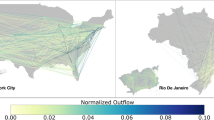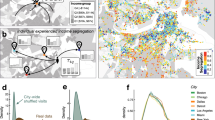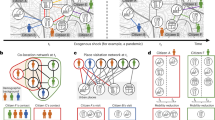Abstract
Cities provide access to stores, public amenities and other people, but that access may provide less benefit for the lower-income and younger urbanites who lack money and means of easy mobility. Using detailed GPS location data, we measure the urban mobility and experienced racial and economic isolation of the young and the disadvantaged. We find that students in major metropolitan areas experience more racial and income isolation, spend more time at home, stay closer to home when they do leave, and visit fewer restaurants and retail establishments than adults. Looking across levels of income, students from higher-income families visit more amenities, spend more time outside of the home, and explore more unique locations than low-income students. Combining a number of measures into an index of urban mobility, we find that, conditional on income, urban mobility is positively correlated with home neighborhood characteristics such as distance from the urban core, car ownership and social capital.
This is a preview of subscription content, access via your institution
Access options
Subscribe to this journal
Receive 12 digital issues and online access to articles
$119.00 per year
only $9.92 per issue
Buy this article
- Purchase on SpringerLink
- Instant access to full article PDF
Prices may be subject to local taxes which are calculated during checkout


Similar content being viewed by others
Data availability
The primary data that support the findings are provided by Replica, an urban data platform, and are provided under a restricted agreement for the current study. Therefore, it is not publicly available. Other data in the study come from the census and are accessed via IPUMS, a database of census and survey data housed at the University of Minnesota, as well as from Opportunity Insights, an economics research laboratory at Harvard.
Code availability
The primary data that support the findings are provided by Replica, an urban data platform, and are provided under a restricted agreement for the current study and are thus not publicly available. As running the code for this Article requires proprietary data, it is also not publicly available, but can be provided upon request.
References
Kain, J. F. Housing segregation, negro employment, and metropolitan decentralization. Q. J. Econ. 82, 175–197 (1968).
Taeuber, K. E. & Taeuber, A. F. Negroes in Cities: Residential Segregation and Neighborhood Change (Atheneum, 1969).
Brooks-Gunn, J., Duncan, G. J., Klebanov, P. K. & Sealand, N. Do neighborhoods influence child and adolescent development? Am. J. Sociol. 99, 353–395 (1993).
Cutler, D. M. & Glaeser, E. L. Are ghettos good or bad?. Q.J. Econ. 112, 827–872 (1997).
Sampson, R. J., Morenoff, J. D. & Gannon-Rowley, T. Assessing ‘neighborhood effects’: social processes and new directions in research. Ann. Rev. Sociol. 28, 443–478 (2002).
Chyn, E. & Katz, L. F. Neighborhoods matter: assessing the evidence for place effects. J. Econ. Perspect. 35, 197–222 (2021).
Chyn, E., Collinson, R. & Sandler, D. The long-run effects of residential racial desegregation programs: evidence from gautreaux. Working paper (2023).
Athey, S., Ferguson, B., Gentzkow, M. & Schmidt, T. Estimating experienced racial segregation in US cities using large-scale GPS data. Proc. Natl Acad. Sci. USA 118, e2026160118 (2021).
Wong, D. W. & Shaw, S.-L. Measuring segregation: an activity space approach. J. Geograph. Syst. 13, 127–145 (2011).
Shelton, T., Poorthuis, A. & Zook, M. Social media and the city: rethinking urban socio-spatial inequality using user-generated geographic information. Landsc. Urban Plan. 142, 198–211 (2015).
Wang, Q., Phillips, N. E., Small, M. L. & Sampson, R. J. Urban mobility and neighborhood isolation in America’s 50 largest cities. Proc. Natl Acad. Sci. USA 115, 7735–7740 (2018).
Beiró, M. G. et al. Shopping mall attraction and social mixing at a city scale. EPJ Data Sci. 7, 28 (2018).
Cagney, K. A., York Cornwell, E., Goldman, A. W. & Cai, L. Urban mobility and activity space. Ann. Rev. Sociol. 46, 623–648 (2020).
Moro, E., Calacci, D., Dong, X. & Pentland, A. Mobility patterns are associated with experienced income segregation in large US cities. Nat. Commun. 12, 4633 (2021).
Browning, C. R., Pinchak, N. P., Boettner, B., Calder, C. A. & Tarrence, J. Geographic isolation, compelled mobility, and everyday exposure to neighborhood racial composition among urban youth. Am. J. Sociol. 128, 914–961 (2022).
Chetty, R. & Hendren, N. The impacts of neighborhoods on intergenerational mobility I: childhood exposure effects*. Q. J. Econ. 133, 1107–1162 (2018).
Owens, A. Inequality in children’s contexts: income segregation of households with and without children. Am. Sociol. Rev. 81, 549–574 (2016).
Cook, C. Heterogeneous Preferences for Neighborhood Amenities: Evidence from GPS Data (SSRN, 2023); https://ssrn.com/abstract=4212524
Spiegelman, M. Race and Ethnicity of Public School Teachers and Their Students (NCES, 2020); https://nces.ed.gov/pubs2020/2020103/index.asp
Glaeser, E. L. & Mare, D. C. Cities and skills. J. Labor Econ. 19, 316–342 (2001).
Chetty, R. & Hendren, N. The impacts of neighborhoods on intergenerational mobility II: county-level estimates. Q. J. Econ. 133, 1163–1228 (2018).
Chetty, R. et al. Social capital I: measurement and associations with economic mobility. Nature 608, 108–121 (2022).
Chetty, R. et al. Social capital II: determinants of economic connectedness. Nature 608, 122–134 (2022).
Couture, V., Gaubert, C., Handbury, J. & Hurst, E. Income Growth and the Distributional Effects of Urban Spatial Sorting. Technical Report w26142 (National Bureau of Economic Research, 2019); http://www.nber.org/papers/w26142.pdf
Couture, V. & Handbury, J. Neighborhood change, gentrification and the urbanization of college graduates. J. Econ. Perspect. 37, 29–52 (2023).
Levy, B. L., Phillips, N. E. & Sampson, R. J. Triple disadvantage: neighborhood networks of everyday urban mobility and violence in US cities. Am. Sociol. Rev. 85, 925–956 (2020).
Candipan, J., Phillips, N. E., Sampson, R. J. & Small, M. From residence to movement: the nature of racial segregation in everyday urban mobility. Urban Studies 58, 3095–3117 (2021).
Brazil, N. Environmental inequality in the neighborhood networks of urban mobility in us cities. Proc. Natl Acad. Sci. USA 119, e2117776119 (2022).
Xu, W. The contingency of neighbourhood diversity: variation of social context using mobile phone application data. Urban Studies 59, 851–869 (2022).
Chang, S. et al. Mobility network models of COVID-19 explain inequities and inform reopening. Nature 589, 82–87 (2020).
Allcott, H. et al. What Explains Temporal and Geographic Variation in the Early US Coronavirus Pandemic? Technical Report w27965 (National Bureau of Economic Research, 2020); http://www.nber.org/papers/w27965.pdf
Couture, V., Dingel, J. I., Green, A., Handbury, J. & Williams, K. R. JUE insight: measuring movement and social contact with smartphone data: a real-time application to COVID-19. J. Urban Econ. 127, 103328 (2021).
Chen, M. K., Chevalier, J. A. & Long, E. F. Nursing home staff networks and COVID-19. Proc. Natl Acad. Sci. USA 118, e2015455118 (2021).
Chen, M. K., Haggag, K., Pope, D. G. & Rohla, R. Racial disparities in voting wait times: evidence from smartphone data. Rev. Econ. Stat 104, 1341–1350 (2022).
Atkin, D., Chen, K. & Popov, A. The Returns to Serendipity: Knowledge Spillovers in Silicon Valley. Working Paper 30147 (National Bureau of Economic Research, 2020).
Miyauchi, Y., Nakajima, K. & Redding, S. J. Consumption Access and Agglomeration: Evidence from Smartphone Data. Working Paper 28497 (National Bureau of Economic Research, 2021).
Birant, D. & Kut, A. ST-DBSCAN: an algorithm for clustering spatial-temporal data. Data Knowl. Eng. 60, 208–221 (2007).
White, M. J. The measurement of spatial segregation. Am. J. Sociol. 88, 1008–1018 (1983).
Logan, J. R., Minca, E. & Adar, S. The geography of inequality: why separate means unequal in American public schools. Sociol. Educ. 85, 287–301 (2012).
Logan, J. R., Zhang, W. & Oakley, D. Court orders, white flight and school district segregation, 1970–2010. Social Forces 95, 1049–1075 (2017).
Acknowledgements
This project was reviewed and determined exempt by the Stanford Institutional Review Board (protocol IRB-62185). E.G. acknowledges support from the Star Family Challenge for Promising Scientific Research. The funders had no role in study design, data collection and analysis, decision to publish or preparation of the manuscript. No specific funding was provided for this work. C.C. was a contractor with Replica before the beginning of this study and no longer has any material financial interests. We thank K. Jain and A. Pozdnoukhov at Replica for facilitating access to the data.
Author information
Authors and Affiliations
Contributions
All authors contributed equally.
Corresponding author
Ethics declarations
Competing interests
The authors declare no competing interests.
Peer review
Peer review information
Nature Cities thanks Christopher Browning and the other, anonymous, reviewer(s) for their contribution to the peer review of this work.
Additional information
Publisher’s note Springer Nature remains neutral with regard to jurisdictional claims in published maps and institutional affiliations.
Supplementary information
Supplementary Information
Supplementary Sections A.1–A.4, discussing data, and Supplementary Sections B.1–B.4, presenting additional results mentioned in the main text.
Rights and permissions
Springer Nature or its licensor (e.g. a society or other partner) holds exclusive rights to this article under a publishing agreement with the author(s) or other rightsholder(s); author self-archiving of the accepted manuscript version of this article is solely governed by the terms of such publishing agreement and applicable law.
About this article
Cite this article
Cook, C., Currier, L. & Glaeser, E. Urban mobility and the experienced isolation of students. Nat Cities 1, 73–82 (2024). https://doi.org/10.1038/s44284-023-00007-3
Received:
Accepted:
Published:
Issue date:
DOI: https://doi.org/10.1038/s44284-023-00007-3
This article is cited by
-
Visitation patterns reveal service access disparities for ageing populations in the USA
Nature Human Behaviour (2025)
-
Exploring the safe and just space for urban and regional Australia
npj Urban Sustainability (2025)
-
A visitor-enriched census in the U.S. cities using large-scale mobile positioning data
Scientific Data (2025)
-
Soundscape co-governance for a healthy megacity
npj Urban Sustainability (2025)
-
Urban youth most isolated in largest cities
Nature (2024)



